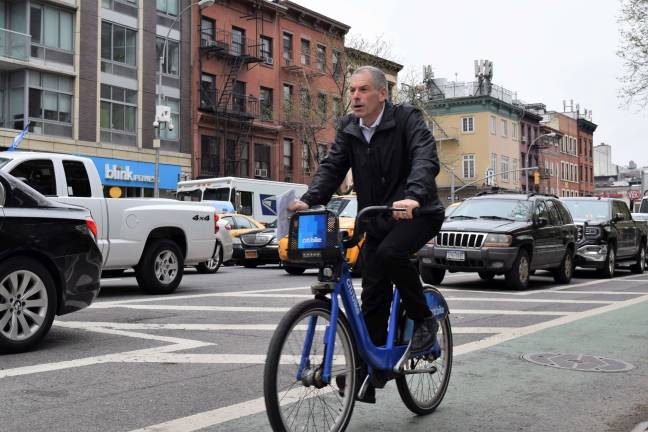DOT Touts Bike Safety Data

Cyclist fatality rates have dropped, study shows
By Michael Garofalo
It’s not your imagination: there are way more bikes on the streets than there used to be. From 2006 to 2015, the number of annual bicycle trips on New York City streets grew 150 percent. According to a new Department of Transportation study, the dramatic increase in ridership has been accompanied by a precipitous decline in the rate of fatalities and serious injuries.
“Overall, the rate of cycling fatalities and serious injuries has really dropped as our numbers have risen,” DOT Commissioner Polly Trottenberg said at a July 31 press conference announcing the findings of the “Safer Cycling” study near the pedestrian and cyclist entrance to the Brooklyn Bridge in Brooklyn. The number of annual cyclist fatalities in New York has remained relatively flat over the last decade, Trottenberg said, but data shows that safety has improved significantly when increased ridership is taken into account. On a per trip basis, the study says, the fatality rate for cyclists dropped 71 percent between 2000 and 2015.
DOT officials and bicycle advocates have suggested that the reduced rate of accidents, even as the number of bikes on the road has grown, is evidence of the so-called “safety in numbers” theory, which holds that cycling ridership and cycling injuries and deaths are inversely correlated. “The more bikers out there on the streets, the safer it is for everyone,” said Paul Steely White, the executive director of Transportation Alternatives, a pedestrian, bike and transit advocacy group.
But despite encouraging data on bicycle safety, Trottenberg said there is still work to be done. Five cyclists died in Manhattan during the first six months of 2017, according to city data, including three in June.
One of the DOT’s priorities in improving bicycle safety is expanding the city’s network of bike lanes. According to the report, 89 percent of fatal bike collisions between 2006 and 2016 occurred on streets without bike lanes.
Advocates have placed particular emphasis on increasing the number of protected bike lanes, which shield cyclists from passing vehicle traffic with a buffer of parallel street parking and pedestrian crossing islands. Currently, 425 of the city’s 1,133 miles of bike lanes are protected.
“The difference between mere painted lanes that provide only a modicum of protection and protected lanes is very stark,” White said. “You see that in the data and you see that in the perception of safety that people have when deciding whether or not they want to ride.”
Bike lanes have emerged as a topic of controversy in many neighborhoods, where some residents complain of unsafe conditions caused by cyclists riding in the wrong direction or otherwise not following traffic regulations. Many bike critics have complained of a lack of enforcement targeting cyclist violations on the part of police. Dennis Fulton, an inspector with the NYPD’s transportation bureau, explained that moving violations written to vehicle drivers outnumber summons given to cyclists by a roughly 75-to-one margin. “Our enforcement is generally geared toward vehicles,” Fulton said, adding, “They’re going to cause the most damage and that’s where our priorities lie right now.”
Early next year, the DOT will release a study of best practices for improving bicycle safety at intersections, where nearly 90 percent of cyclist fatalities and severe injuries occur.
“Everybody you talk to, be they motorists, cyclists or pedestrians, thinks that everybody else is not following the rules,” Trottenberg said. “We all need to share the roadways.”